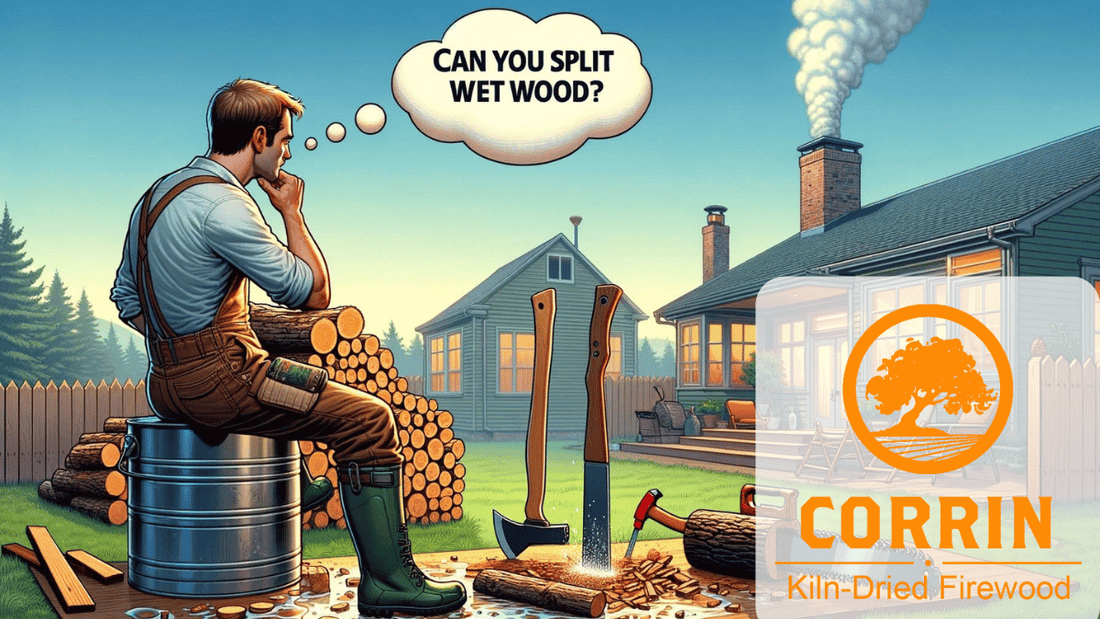Splitting firewood is essential for many households, especially those that rely on wood-burning stoves or fireplaces for warmth and cooking. But when it comes to splitting wood, one common question arises: Is it easier to split wet or dry wood?
Understanding the nature of wood and how it reacts to moisture is crucial in answering this question. In this article, we delve into the complexities of splitting wet versus dry wood, the potential dangers of handling wet wood, and why kiln-dried firewood from Corrin Kiln Dried Firewood Co. is the optimal choice for burning and cooking.
Does Wood Change When It Gets Wet?
Wood is a hygroscopic material that naturally absorbs and releases environmental moisture. When wood gets wet, the moisture content increases, causing the fibers to swell. This swelling can make the wood harder to cut or split because the fibers become tougher and more resistant to breaking apart. Additionally, wet wood is heavier, adding a physical challenge to the splitting process.
Does Wood Need to Dry Before Splitting?
Technically, you can split both wet and dry wood. However, the ease and efficiency of splitting greatly depend on the wood's moisture content. While splitting wet wood is possible, it generally requires more effort and can be more time-consuming than splitting dry wood. With its reduced moisture content, dry wood tends to be more brittle and cracks more readily when force is applied. This characteristic makes dry wood, mainly wood that has been correctly seasoned or kiln-dried, significantly easier to split.
The Real Dangers of Splitting Wet Wood
Splitting wet wood is not only more labor-intensive but also poses certain risks. Damp wood's increased density and weight make it more challenging to handle, potentially leading to physical strain or injury. Moreover, using tools like axes or mauls on wet wood increases the risk of the tool slipping or bouncing back, which can lead to accidents.
Use a Log Splitter for Wet WoodIf you must split wet wood, using a mechanical log splitter can reduce the physical exertion required and minimize the risk of injury. Log splitters are designed to handle the increased resistance of wet wood efficiently. However, even with a log splitter, dry wood remains easier and safer to process.
Dry Wood Is Typically Easier to SplitWhen it comes down to it, dry wood is the preferred choice for splitting. The reasons are clear: it's lighter and less dense, and the wood fibers separate more easily under pressure. Dry wood, especially kiln-dried wood, has a moisture content that is ideally suited for burning, producing a hotter and cleaner flame with less smoke and creosote buildup in your chimney.
Kiln drying is a controlled process that rapidly reduces the moisture content of the wood, making it ideal for burning and cooking. This process makes the wood easier to split and enhances its burning qualities, ensuring a high-quality, efficient fuel for your fire.
Where to Buy Kiln Dried Firewood
For those seeking the best firewood for burning and cooking, look no further than Corrin Kiln Dried Firewood Co. Our kiln-dried firewood is meticulously processed to ensure the optimal moisture content, providing you with easy-to-split, clean-burning wood that takes your fires to the next level.
Whether you're cooking up a feast in your wood-fired oven or seeking the cozy warmth of a fireplace, our firewood delivers superior performance. Order online or call us at 302-656-6077 to secure your supply. We offer free delivery within 20 miles of 19801, with a nominal fee of only $3 per additional mile, making accessing the best firewood on the market convenient and cost-effective.
Key Takeaways
The debate between splitting wet wood versus dry wood leans heavily in favor of dry wood, particularly kiln-dried wood. Not only is dry wood easier and safer to split, but it also offers superior burning characteristics, making it the ideal choice for warmth and cooking. Choosing Corrin Kiln Dried Firewood Co. for your firewood needs ensures a high-quality, efficient fuel that enhances your fire-burning experience. Remember, the right firewood makes all the difference in achieving a superior burn.

